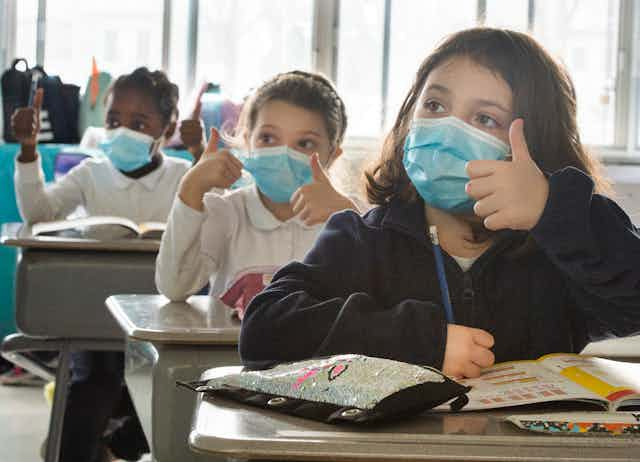My time as a medical student showed me that one of the most challenging things a parent can face is a sick child, whether the illness is from dehydration, appendicitis or cancer.
The COVID-19 pandemic has also led to childhood hospitalizations. Fortunately, the COVID vaccine offers significant protection. Unvaccinated adolescents were 10 times more likely to be hospitalized than vaccinated. However, of all children infected by the virus throughout the pandemic, vaccinated and unvaccinated, roughly one out of 100 children needed to be hospitalized, which indicated disease so severe they require medical intervention to keep them safe and alive.
As the Omicron wave has started to settle, governments have begun to debate the necessity of continued pandemic measures, including school mask requirements. As a medical doctor and scientist investigating COVID-19, I’ll be discussing what readers need to know to have an informed opinion on possible changes at schools.
Public health measures work
Given the recent protests against public health measures, such as the anti-vaccine-mandate truck convoy that occupied Ottawa, it is clear that some people question whether such directives provide benefits.
Vaccines offer protection against COVID-19, including the Omicron variant. Vaccine mandates have helped move the pandemic closer to a resolution, as observed in Canada.

Motivating people to get vaccinated leads to more vaccinations, and fewer people getting sick. More people can then live semi-normal lives, meaning economies can recover, and the availability and cost of essential goods improve.
Masks and social distancing offer protection and have had their importance appropriately iterated continuously throughout the pandemic. These measures are essential because they directly address the way the virus is transmitted.
Social distancing puts more distance between you and another individual’s virus particles. This makes it harder to breathe them in, because they are diluted in the air.
Masks can capture and block particles coming from other people, artificially creating distance between one person’s respiratory secretions and another person’s airway. This offers another layer of protection against respiratory particles.
Polarizing rhetoric
It is easy to understand how these measures can help bring back normalcy. Unfortunately, certain players have made these measures — which have likely saved thousands if not millions of lives — into thorny political topics. Confidently expressed and polarizing rhetoric has power and can make intelligent and caring individuals question common-sense measures.

It is reasonable to think that people are less likely to follow inconvenient directives when they question or do not fully understand them. Fortunately, masking by students at schools demonstrates a clear advantage when considering protecting children, and also their families when children exposed to the virus bring it back home.
In October 2021, the Centers for Disease Control and Prevention (CDC) in the United States published a series of peer-reviewed articles on the data behind masking in schools. The first study showed that in U.S. counties with school mask requirements, the number of COVID-19 cases was reduced by at least half.
The data demonstrated a robust statistical relationship between masking and children being protected, meaning that the decreased number of sick children in counties with mask requirements was due to masking.
The second study, which focused on counties in Arizona, showed once again that mask requirements meant safer kids. Schools without mask requirements were over three times as likely to have a COVID-19 outbreak compared to schools with requirements.
Clear evidence
Remember that I said kids can get seriously sick from COVID-19? The evidence is clear that masks protect children. When someone claims that they do not or that mask mandates stifle freedom, they are choosing to allow children to get sick with COVID-19, with the knowledge that some of those children will require hospitalization and some will die.

Appropriately, the CDC and the American Academy of Pediatrics continue to recommend masking for all children over age two, and for everyone at schools, regardless of vaccination status.
At this point in the pandemic, it is reasonable to assume that many people have an opinion on everything related to COVID-19. I believe in public health measures being sustained until we have evidence that it is safe to gradually lift them, which is happening to some extent currently.
While COVID-19 will likely be with us for at least a few more years, we are moving towards living with the virus. Safety measures will likely fluctuate as the number of cases evolves.
We must not forget what we have gone through because we can count on cases rising again in the future. We must remain ready to do our part in serving our neighbours, children and countries by contributing what we can to fight disease. We all have a role in mitigating the pandemic’s effects on peoples’ health, lives and livelihoods, and on our shared economy. Following health-care directives is the most patriotic thing anyone can do. It expresses a commitment to our present and future, and to a more stable world for our children.

